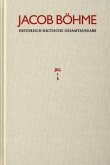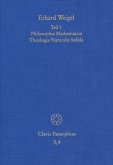Robert Fludd's (1574-1637) 'Utriusque Cosmi Historia' is a key work of mystical »Naturphilosophie« in the early modern era. It is an encyclopedia of all those theories excluded from the scientific canon due to their alleged superstition and irrationality. Fludd - medical scientist, astrologist, Kabbalist, mathematician and »Naturphilosoph« - develops a cosmology that depicts the influence of the stars on world events, as well as illustrating and describing in detail all the man-made arts and technologies during this period, which are explained in analogy with their celestial archetypes. - The many illustrations make this book the most beautiful encyclopedia of the early modern era.Band 1: De metaphysico macrocosmi et creaturarum illius ortu. Physicomacrocosmi in generatione et corruptione progressu. Oppenheim 1617.This volume presents the history of creation and illustrates it with pictures, beginning with the creation of heaven and earth, followed by the emergence of plants, animals and, finally, man.Band 2,1-2: De physico macrocosmi et creaturarum illius ortu. De naturae simia seu technica macrocosmi historia. Oppenheim 1618This volume contains an extensive and visual depiction of the human arts, covering mathematics, music, optics, painting, military technology, the study of automata, meteorology and astrology.Band 3: De supernaturali praeternaturali et contranaturali microcosmi historia. Oppenheim 1619. De technica microcosmi historia. [Oppenheim 1620]The third volume introduces Fludd's metaphysics and physics. His metaphysics is an outline of a speculative arithmetic based on Nicholas of Cusa's ideas; his physics illustrates in words and pictures the relation of microcosm and macrocosm and can thus be regarded as an overall view of Renaissance medicine and anthropology.Band 4: De praeternaturali utriusque mundi historia. Frankfurt 1621. Anatomiae Amphitheatrum. Frankfurt 1623In the fourth volume, Fludd presents the Kabbalistic and Pythagorean basics of his encyclopedic theory. This work is the first major overall depiction of the Christian Kabbalah in the early modern period.
»Die ganze Welt in einem Buch: Die wichtigste Enzyklopädie der Frühen Neuzeit, Robert Fludds 'Geschichte beider Kosmen', ist in einer vollständigen und herausragend edierten Faksimile-Ausgabe erschienen. Das ist eine Sensation.« Dirk Pilz, Frankfurter Rundschau »Stöbert man in den fünf Bänden, die Herausgeber Wilhelm Schmidt-Biggemann mit glänzend klaren Erläuterungen versehen hat, so erlebt man ein Feuerwerk an Untersuchungen, Ideen, Spekulationen. Die Entstehung der Elemente, Verknüpfungen von Makro-und Mikrokosmos und heute ziemlich wild wirkende theologische Überlegungen fügen sich zum Gesamtkunstwerk. [...] Dem in Stuttgart-Bad Cannstatt ansässigen Verlag Frommann-Holzboog ist eine epochale editorische Großtat gelungen, die durchaus ihren Preis hat. Aber man kann die «Geschichte beider Kosmen» durchaus als doppelte Investition ansehen: einmal als ziemlich langen und wichtigen Begleiter seiner Lebens- und Lesezeit und als derzeit wohl exklusivstes Coffee Table Book.« Jörn Florian Fuchs, Wiener Zeitung








